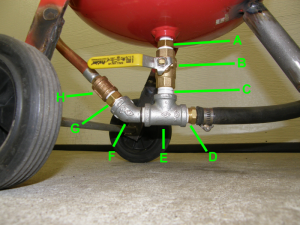Since we don’t want to go to the sandblaster with all the rusty parts, we have we bought a sandblasting cabinet. It works really well and I can recommend it. Especially with a or several Land Rovers.
A cabinet is easy to build yourself. Ours is bought though. The principle is easy. The blasting gun sucks up the grid with the airflow. After the blasting the grit goes back to the bottom of the cabinet where the cycle starts over. The downside of this set up is that you need a large air compressor and a part of the pressure is used to suck up the grid. So when you set the compressor at 7 bar, you won’t be blasting at 7 bar.
There is another way of blasting. It’s with a pressure pot. With this set up you have an air tank half filled with grid and pressurized. Because of the pressure, the grid is pushed out instead of sucked up. Another hose gets pressured air to the part where the grid exits the tank. This way you lose no pressure and you can blast at just 4 or 5bar instead of 8 bar with the suck up system. There for its way more effective and it blasts way faster than with the old setup. With the pressure pot we can blast 6 times faster than with the suck up system. I can do a brake caliper in about 6 minutes.
The downside is that the pressure pot is made in china and it has some design flaws. The valve that regulates the grit flow tends to get blocked by sand that is sticking together because of water that is pumped in when it’s really humid outside. Or just by rust or paint parts.
Therefor we are going to modify the valve and make it larger.


